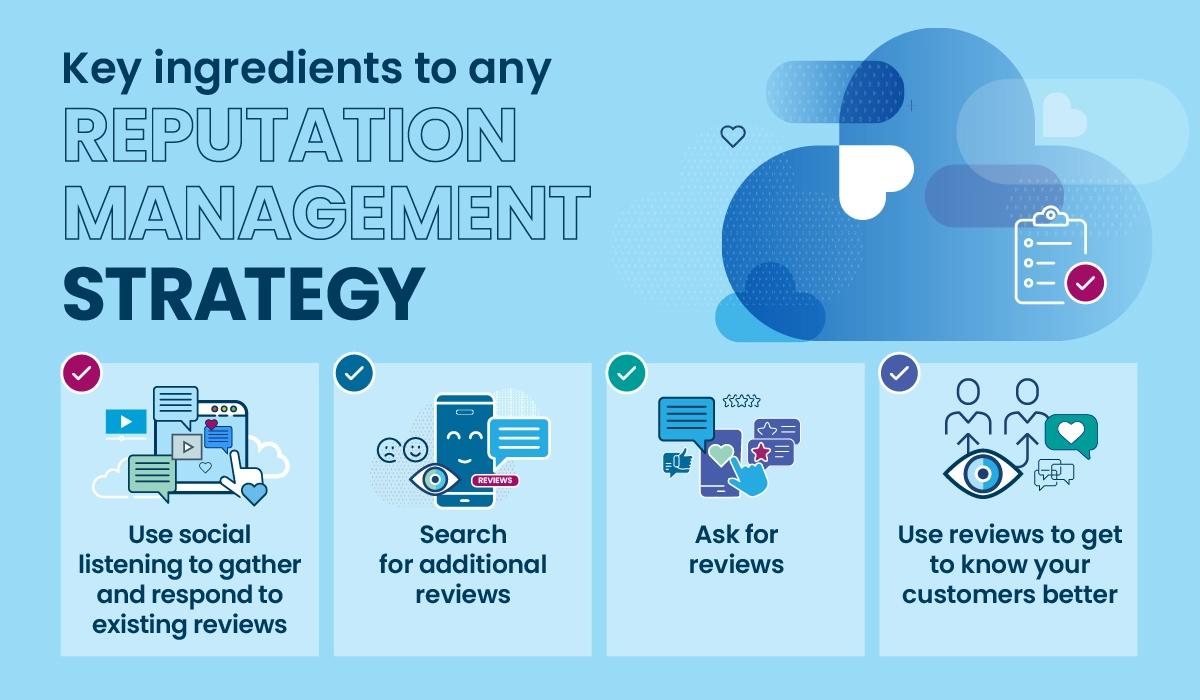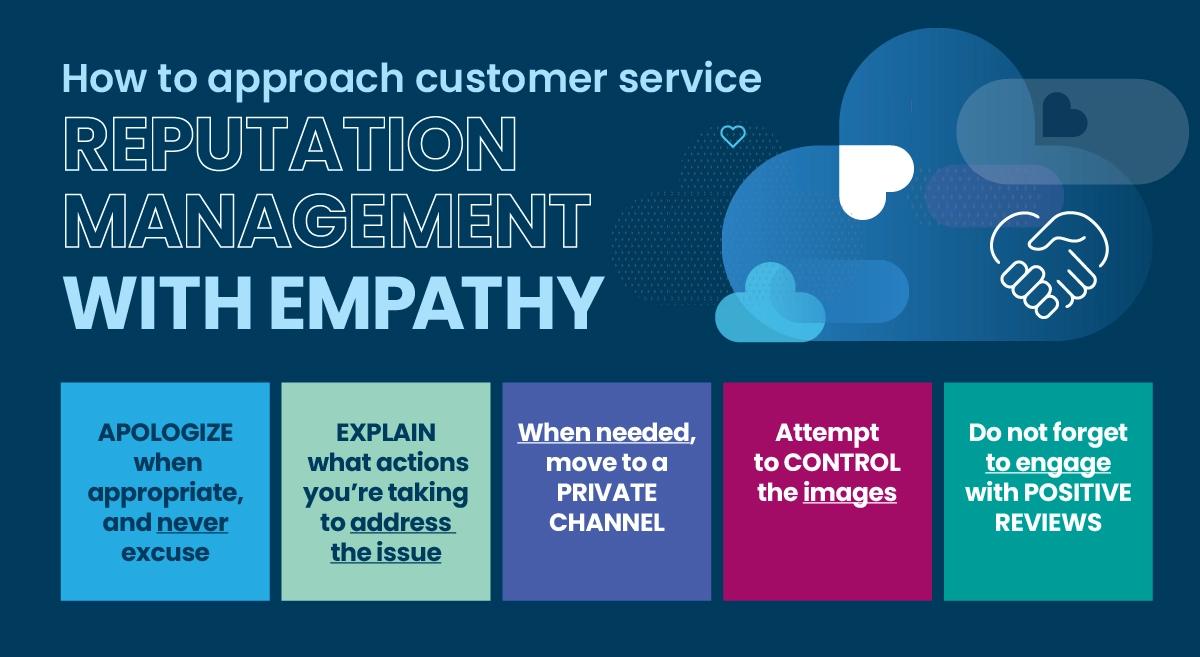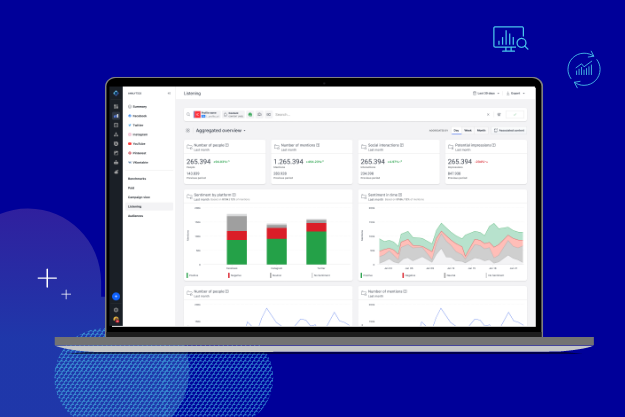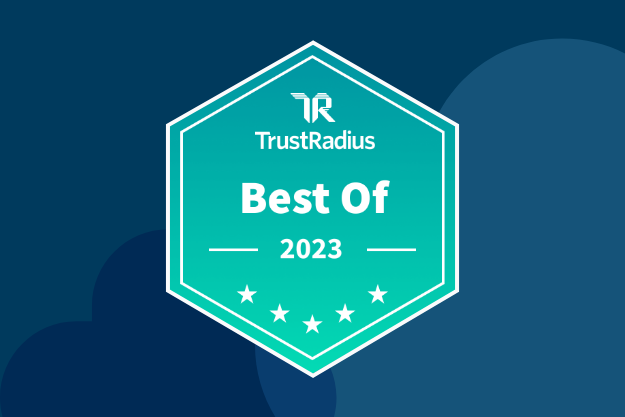Every day, your company’s reputation is on the line. Ultimately, this will be decided by what your company as a whole can deliver, but people in the early stages of the customer journey may never get further if they encounter too much negativity – or not enough positivity – when researching your company online.
The ratings and reviews that are littered throughout forums and social media have real value, and review management is an integral part of creating and maintaining a great reputation. Considering all of the different places that customers (and potential ones) can let their voices be heard about your company, it’s not an easy task.
It’s an incredibly important one, though, because the reviews people encounter are often the first thing they learn about your company. And as we all know, good first impressions are essential to creating positive relationships.
So, how do you achieve this? First, understand what reputation management is all about, and then craft a reputation management strategy driven by empathy that will empower your team and help you rise to the top of the reviews and of the mind of your potential customers.
What is reputation management?
Reputation management is about improving the way that customers or prospects feel about your company based on what they read or hear about you. Sometimes referred to as review management, this is most often performed by staying on top of the things said about your company online.
Reputation management used to be much simpler when there were fewer places to monitor. However, the multitude of review sites and social media platforms today makes it a crucial, full-time task.
Imagine you’re looking to buy a new piece of furniture. Outside of word-of-mouth recommendations from people you trust, you're likely to start with a Google search that will show multiple options with each having reviews. Alternatively, you may even go straight to a review site to see what people have said about the company or even the specific item you're looking to purchase.
If the first thing you encounter is several negative reviews or an overall low star rating, you're likely going to skip over that company. But that’s especially true if there are many negative reviews and no responses to these reviews from the company itself.
This is where the importance of brand reputation management comes into play.
Through social media listening, social media monitoring, and regular tracking of review-based websites, your team can play a role in the first impression that potential customers have, while also addressing the complaints, needs, and even compliments of current customers.
Why reputation management is important for brands
Here's a look at some of the numbers that indicate why reputation management is such an important piece of successful businesses in today’s environment:
According to a Bright Local survey, 46% of consumers feel that online business reviews are as trustworthy as personal recommendations from friends or family.
96% of customers specifically look for negative reviews, and what consumers are looking for exactly are the company’s pain points. This helps the customer to know what to expect with the product or service.
People are increasingly turning to social media across the customer journey, including 68% currently using (or planning to use) social media to ask questions before making a purchase, and 59% to get post-purchase support.
Search Engine Journal reveals TikTok’s recent impact as a path-to-purchase for brands shows, as discovery happens on TikTok 1.1x more than on other platforms. And 58% of TikTok users convinced another person to use a product, which shows the power of community on that platform.
Brands’ response times remain notably longer than what consumers expect from brands, with 52% expecting brands to respond to their questions within one hour.
People expect rapid responses. But more than that, they want to see results and feel like their problems (or compliments) are being seen and understood.
To achieve that, you have to have the right strategy.
Key ingredients to any reputation management strategy

Just like other elements of your business, including crisis management and community management, success starts with having a plan. First, we will look at some big-picture strategies to help your team find where they need to monitor to manage your brand’s reputation. Then, we will discuss some specific strategies for dealing with comments.
Use social listening to gather and respond to existing reviews
To respond to reviews or comments quickly and effectively, you first need to know where they are. A great social listening tool is critical for achieving this, especially at scale when simply perusing the platforms would be infeasible.
With a social listening tool like Emplifi, you can canvass a vast array of messages in just a few simple steps.
1. Define social listening objectives
Looking for the latest trends that affect your industry, or trying to establish what is being said about your brand? You can accomplish this and more with a social media listening tool. However, selecting your primary objective helps prioritize the task that matters most at the time.
2. Design social listening queries
This is where you can get specific by searching keywords, #hashtags, and @mentions. You can also dig deeper with "include/exclude" or "any/all" between keywords, as well as "and/or" between conditions.
3. Choose data sources
Conversations are different on different platforms. As such, search for what you want to see on Facebook, Instagram, or Twitter. Also, filter by country, and exclude specific authors/profiles if they are not relevant.
Search for additional reviews
Depending on your business and social media listening tool, your team may need to search for other places where conversations about you are taking place. For example, restaurants rely heavily on Tripadvisor and Yelp, while a company that does home repairs might primarily rely on Yelp and Angi.
Monitoring Google Reviews is critical for nearly every business, but there are likely some more niche sites to stay on top of in your industry, too (e.g. Avvo for lawyers, G2 for software comparisons). Once you know what sites host the most conversations about your company, prioritize the monitoring of those sites so that your response time reflects that you are listening and that you care.
Ask for reviews
One way to help your team monitor the right places and deliver quick response times is by asking for or encouraging reviews on your preferred review platforms.
Think of the restaurant example; after a good meal, how many times has the server asked you to leave a positive review on Tripadvisor or Yelp (or Google, or Facebook, etc.)? It's likely happened several times because this industry, more than most, understands the power of positive reviews on the right platforms.
But they are far from the only businesses that can benefit from this tactic. B2B businesses could ask for reviews or recommendations on LinkedIn or comparison sites like G2, while eCommerce businesses encourage Amazon reviews in addition to those on their site.
If a customer has a bad experience, they are not one you want to encourage to share their feedback but, after positive interactions, it can greatly benefit your brand to do so where it matters the most.
Use reviews to get to know your customers better
A review reflects one person’s experience with your company. What do 10 reviews tell you? How about 100, or 1,000?
Reviews drive your reputation management. Ensure your team is equipped to really listen to them and see what you can learn. Are customers consistently praising or complaining about a specific part of your business? If you have multiple locations, does one stand above the rest?
Part of a reputation management strategy should be compiling the messages your brand receives and combing through them for areas to improve, or services to emphasize if they are consistently doing well.
Social listening tools can help in terms of sentiment analysis, but deeper learning will also come from the specifics of your industry or company and how you’re interacting with customers.
Approaching customer service reputation management with empathy
Now that we have looked at strategies for gathering and analyzing reviews that will help dictate your company’s reputation, it’s important to talk about some of the tactics your team can deploy for individual responses.
To avoid being one of the companies that go viral as an example of bad reputation management, follow this advice to help improve your reputation and maybe even turn some bad reviews into positive ones.

Apologize when appropriate, and never excuse
If someone is complaining about a bad product or experience with your company, it’s important not to start from a defensive position. Acknowledge their feelings, apologize for the situation, and avoid making excuses that might make them feel like you are brushing the situation aside.
Think of it from their point of view; as a customer, you are much more likely to turn from a negative opinion to a neutral or positive one if you feel heard and that your bad experience is acknowledged up front.
Explain what actions you’re taking to address the issue
So, what is your team going to do about it?
Customers want to know how you are going to fix their problem. This is an area that can impact the opinion of potential customers as they see how you’ve addressed previous comments or issues.
It is important not to over promise in this situation; avoid saying they will receive a new product the next day if you don’t know that’s 100% the case, because that could lead to more issues.
As a reputation manager or social media manager, be clear and concise about how you and the company are working to solve the issue.
When needed, move to a private channel
Long back-and-forths on Facebook or a review forum are not helpful. Once you've addressed the basic complaint or issue, and further steps or more specifics are required, move to a private communication so that you can delve into the customer’s details.
Attempt to control the images
This one is getting into the weeds a bit. However, people base a lot of opinions on images, and the first ones they see leave lasting impressions.
Some review sites allow your business to upload its featured photos, while others might allow you to select the user-uploaded images that will be featured. Try to take advantage, as it is one more way to get started on the right foot with a new potential customer.
Don't forget to engage with positive reviews
When we think about review management, the focus is often on controlling negative reviews before they hurt your reputation. But positive reviews are just as, if not more, important.
Replying to positive reviews accomplishes several things, including:
Creating a bond that potentially turns a one-time customer into a repeat customer
Showing other customers that you are paying attention and enjoy delivering great service or products
Cultivating brand ambassadors who can help spread the word about how great you are
Celebrate and acknowledge the successes when they happen. It’s a win-win for you and your customers.
Examples of online reputation management
Nearly every business must deal with online reputation management to some degree. Although, for customer-facing businesses, it is an even higher priority and can be more time-consuming. Here are a couple of examples that show the different types of interactions that businesses must have every day.
Southwest Airlines

In this example, a Southwest Airlines customer reached out on social media to express their dissatisfaction with a flight cancellation and not receiving a refund for an error on the company’s part. In less than an hour, Southwest Airlines responded to the customer's message and assured them that they would work to resolve the issue and ensure their satisfaction with the service.
This quick and effective response not only addressed the customer's concern but, with the interaction being so public on Twitter, also demonstrated to other potential customers that Southwest Airlines takes their customers' concerns seriously. By doing so, Southwest Airlines is maintaining a positive image and building trust with their customers, essentially winning at reputation mango.
Skyscanner

In this case of reputation management, a glitch occurred where a customer was shown a 47-year layover instead of a direct flight. Rather than apologizing and moving on, Skyscanner leaned into the joke and responded to the customer with a witty comment. This approach not only diffused the situation but also created high user engagement and brand awareness. Skyscanner's response ended up going completely viral.
By turning a negative experience into a funny meme, Skyscanner demonstrated its ability to handle issues in a positive and creative way, which ultimately helped them win at reputation management.
The takeaway
It takes a lot of time and effort, but the benefits of strong online reputation management will reflect in your bottom line, as well as in the hearts and minds of those seeking your services. Get the right social marketing tools to make sure your customers know you empathize with them and get started today.







































